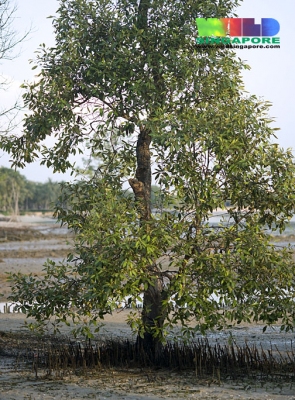Avicennia alba
Blume
Acanthaceae
Common Name:

Solitary tree with lots of pneumatophores (breathing roots)
Photograph by: Ria Tan

General Information
Avicennia alba is a rather richly branched, evergreen shrub or small tree that can grow up to 30 metres tall but is usually much smaller[
]. Growing in the tidal mudflats, it develops roots with many vertical breathing roots above soil level[
299- Title
- Protabase - Plant Resources of Tropical Africa.
- Publication
-
- Author
-
- Website
- http://www.prota.org
- Publisher
-
- Year
- 0
- ISBN
-
- Description
- An excellent on-line database with detailed information on over 3,200 species of useful plants of Africa.
].
The tree is harvested from the wild for its timber and resin.
This species is widespread, is fast-growing and can be locally common. It is threatened by the loss of mangrove habitat throughout its range, primarily due to extraction and coastal development, and there has been an estimated 24% decline in mangrove area within this species range since 1980. Mangrove species are more at risk from coastal development and extraction at the extremes of their distribution, and are likely to be contracting in these areas more than in other areas. It is also likely that changes in climate due to global warming will further affect these parts of the range. Although there are overall range declines in many areas, they are not enough to reach any of the threatened category thresholds. It is classified as 'Least Concern' in the IUCN Red List of Threatened Species.
Known Hazards
None known
Botanical References
Range
E. Asia - coastal areas of the Indian subcontinent, through southeast Asia to the Solomon Islands.
Habitat
Outer mangroves along the shores of tidal rivers and often found as pioneers on exposed mangrove land or after other mangrove species have been cut[
].
Properties
| Conservation Status | Least Concern |
| Medicinal Rating |      |
| Other Uses Rating |      |
| Habit | Evergreen Tree |
| Height | 15.00 m |
| Cultivation Status | Wild |
Cultivation Details
Plants can flower and fruit all year round, especially when growing in the Equatorial zone[
].
Edible Uses
None known
Medicinal
The resin is used for various medical purposes[
].
Agroforestry Uses:
A natural pioneer species in the wild, it could be useful for trying to re-establish mangroves in coastal areas[
K- Title
- Plants for a Future
- Author
- Ken Fern
- Description
- Notes from observations, tasting etc at Plants For A Future and on field trips.
].
Other Uses
A resin is obtained from the tree[
]. It is used medically[
].
The wood is moderately hard[
]. It has an all-round use, e.g. As construction, poles, posts, furniture, boat building and for decorative purposes[
].
It is considered a poor firewood, but is occasionally used for charcoal[
]l.
Propagation
Seed - there is no dormancy, but the seeds are normally sown with the fruit cover removed, because it is highly susceptible to fungus attack[
]. Fresh seeds often have very high germination, typically more than 95%[
]. Seed that has imbibed moisture will usually have radicle formation within 3 days from sowing[
].
Division of root suckers[
].
If you have any useful information about this plant, please leave a comment. Comments have to be approved before they are shown here.
 Useful Tropical Plants Database 2014 by
Ken Fern,
web interface by
Ajna Fern
with help from
Richard Morris.
Useful Tropical Plants Database 2014 by
Ken Fern,
web interface by
Ajna Fern
with help from
Richard Morris.